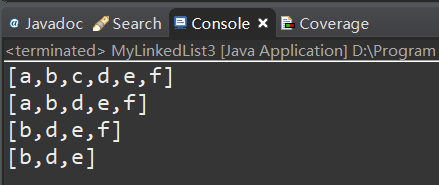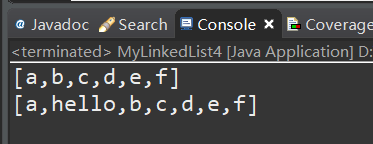理解java容器底层原理--手动实现LinkedList
Node
java 中的 LIinkedList 的数据结构是链表,而链表中每一个元素是节点。
我们先定义一下节点:
package com.xzlf.collection;public class Node {Node previous; // 上一个节点Node next; // 下一个节点Object element; // 元素数据public Node(Object element) {super();this.element = element;}public Node(Node previous, Node next, Object element) {super();this.previous = previous;this.next = next;this.element = element;}}
版本一:基础版本
先创建一个类,完成链表的创建、添加元素、然后重写toString() 方法:
package com.xzlf.collection;/*** 自定义一个链表* @author xzlf**/public class MyLinkedList {private Node first;private Node last;private int size;public void add(Object obj) {Node node = new Node(obj);if(first == null) {first = node;last = node;}else {node.previous = last;node.next = null;last.next = node;last = node;}size++;}@Overridepublic String toString() {StringBuilder sb = new StringBuilder("[");Node tmp = first;while(tmp != null) {sb.append(tmp.element + ",");tmp = tmp.next;}sb.setCharAt(sb.length() - 1, ']');return sb.toString();}public static void main(String[] args) {MyLinkedList list = new MyLinkedList();list.add("a");list.add("b");list.add("c");list.add("a");list.add("b");list.add("c");list.add("a");list.add("b");list.add("c");System.out.println(list);}}
测试:

版本二:增加get() 方法
package com.xzlf.collection;/*** 自定义一个链表* 增加get方法* @author xzlf**/public class MyLinkedList2 {private Node first;private Node last;private int size;public void add(Object obj) {Node node = new Node(obj);if(first == null) {first = node;last = node;}else {node.previous = last;node.next = null;last.next = node;last = node;}size++;}public Object get(int index) {Node tmp = null;// 判断索引是否合法if(index < 0 || index > size - 1) {throw new RuntimeException("索引不合法:" + index);}/*索引位置为前半部分,从头部开始找*/if (index <= size >> 1) {tmp = first;for (int i = 0; i < index; i++) {tmp = tmp.next;}}else {/*索引位置为或半部分,从未部开始找*/tmp = last;for (int i = size -1; i > index; i--) {tmp = tmp.previous;}}return tmp.element;}@Overridepublic String toString() {StringBuilder sb = new StringBuilder("[");Node tmp = first;while(tmp != null) {sb.append(tmp.element + ",");tmp = tmp.next;}sb.setCharAt(sb.length() - 1, ']');return sb.toString();}public static void main(String[] args) {MyLinkedList2 list = new MyLinkedList2();list.add("a");list.add("b");list.add("c");list.add("d");list.add("e");list.add("f");System.out.println(list);System.out.println(list.get(1));System.out.println(list.get(4));}}
测试:

版本三:增加remove() 方法
package com.xzlf.collection;/*** 自定义一个链表* 增加remove* @author xzlf**/public class MyLinkedList3 {private Node first;private Node last;private int size;public void add(Object obj) {Node node = new Node(obj);if(first == null) {first = node;last = node;}else {node.previous = last;node.next = null;last.next = node;last = node;}size++;}public Object get(int index) {Node tmp = null;// 判断索引是否合法if(index < 0 || index > size - 1) {throw new RuntimeException("索引不合法:" + index);}tmp = getNode(index);return tmp == null ? null : tmp.element;}public void remove(int index) {Node tmp = getNode(index);Node up = tmp.previous;Node down = tmp.next;if (tmp != null) {if (up != null) {up.next = down;}if (down != null) {down.previous = up;}// 被删元素是第一个时if(index == 0) {first = down;}// 被删元素是最后一个时if(index == size - 1) {last = up;}size--;}}public Node getNode(int index) {Node tmp = null;/*索引位置为前半部分,从头部开始找*/if (index <= size >> 1) {tmp = first;for (int i = 0; i < index; i++) {tmp = tmp.next;}}else {/*索引位置为或半部分,从未部开始找*/tmp = last;for (int i = size -1; i > index; i--) {tmp = tmp.previous;}}return tmp;}@Overridepublic String toString() {StringBuilder sb = new StringBuilder("[");Node tmp = first;while(tmp != null) {sb.append(tmp.element + ",");tmp = tmp.next;}sb.setCharAt(sb.length() - 1, ']');return sb.toString();}public static void main(String[] args) {MyLinkedList3 list = new MyLinkedList3();list.add("a");list.add("b");list.add("c");list.add("d");list.add("e");list.add("f");System.out.println(list);list.remove(2);System.out.println(list);list.remove(0);// 删除第一个元素System.out.println(list);list.remove(3);// 删除最后一个元素System.out.println(list);}}
测试:

版本四:插入节点
package com.xzlf.collection;/*** 自定义一个链表* 插入节点* @author xzlf**/public class MyLinkedList4 {private Node first;private Node last;private int size;public void add(Object obj) {Node node = new Node(obj);if(first == null) {first = node;last = node;}else {node.previous = last;node.next = null;last.next = node;last = node;}size++;}public void add(int index, Object obj) {Node tmp = getNode(index);Node newNode = new Node(obj);if(tmp != null) {Node up = tmp.previous;up.next = newNode;newNode.previous = up;newNode.next = tmp;tmp.previous = newNode;}}public Object get(int index) {Node tmp = null;// 判断索引是否合法if(index < 0 || index > size - 1) {throw new RuntimeException("索引不合法:" + index);}tmp = getNode(index);return tmp == null ? null : tmp.element;}public void remove(int index) {Node tmp = getNode(index);Node up = tmp.previous;Node down = tmp.next;if (tmp != null) {if (up != null) {up.next = down;}if (down != null) {down.previous = up;}// 被删元素是第一个时if(index == 0) {first = down;}// 被删元素是最后一个时if(index == size - 1) {last = up;}size--;}}public Node getNode(int index) {Node tmp = null;/*索引位置为前半部分,从头部开始找*/if (index <= size >> 1) {tmp = first;for (int i = 0; i < index; i++) {tmp = tmp.next;}}else {/*索引位置为或半部分,从未部开始找*/tmp = last;for (int i = size -1; i > index; i--) {tmp = tmp.previous;}}return tmp;}@Overridepublic String toString() {StringBuilder sb = new StringBuilder("[");Node tmp = first;while(tmp != null) {sb.append(tmp.element + ",");tmp = tmp.next;}sb.setCharAt(sb.length() - 1, ']');return sb.toString();}public static void main(String[] args) {MyLinkedList4 list = new MyLinkedList4();list.add("a");list.add("b");list.add("c");list.add("d");list.add("e");list.add("f");System.out.println(list);list.add(1, "hello");System.out.println(list);}}
测试:

版本五:增加泛型,小的封装
package com.xzlf.collection;/*** 自定义一个链表* 增加泛型,小的封装* @author xzlf**/public class MyLinkedList5<E> {private Node first;private Node last;private int size;public void add(E element) {Node node = new Node(element);if(first == null) {first = node;last = node;}else {node.previous = last;node.next = null;last.next = node;last = node;}size++;}public void add(int index, E element) {checkRange(index);Node tmp = getNode(index);Node newNode = new Node(element);if(tmp != null) {Node up = tmp.previous;up.next = newNode;newNode.previous = up;newNode.next = tmp;tmp.previous = newNode;size++;}}private void checkRange(int index) {if(index < 0 || index > size - 1) {throw new RuntimeException("索引不合法:" + index);}}public E get(int index) {Node tmp = null;// 判断索引是否合法checkRange(index);tmp = getNode(index);return tmp == null ? null : (E) tmp.element;}public void remove(int index) {checkRange(index);Node tmp = getNode(index);Node up = tmp.previous;Node down = tmp.next;if (tmp != null) {if (up != null) {up.next = down;}if (down != null) {down.previous = up;}// 被删元素是第一个时if(index == 0) {first = down;}// 被删元素是最后一个时if(index == size - 1) {last = up;}size--;}}private Node getNode(int index) {checkRange(index);Node tmp = null;/*索引位置为前半部分,从头部开始找*/if (index <= size >> 1) {tmp = first;for (int i = 0; i < index; i++) {tmp = tmp.next;}}else {/*索引位置为或半部分,从未部开始找*/tmp = last;for (int i = size -1; i > index; i--) {tmp = tmp.previous;}}return tmp;}@Overridepublic String toString() {StringBuilder sb = new StringBuilder("[");Node tmp = first;while(tmp != null) {sb.append(tmp.element + ",");tmp = tmp.next;}sb.setCharAt(sb.length() - 1, ']');return sb.toString();}public static void main(String[] args) {MyLinkedList5<String> list = new MyLinkedList5<>();list.add("a");list.add("b");list.add("c");System.out.println(list);list.add(1, "hello");System.out.println(list);System.out.println(list.get(1));}}
测试:
现在我们在编辑上使用add() 方法后已经提示要插入String类型的数据了:

以上代码测试运行结果:

以上代码可能还有部分细节上的bug,不过作为理解LinkedList数据结构的练习应该够用了。
理解java容器底层原理--手动实现LinkedList的更多相关文章
- 理解java容器底层原理--手动实现HashMap
HashMap结构 HashMap的底层是数组+链表,百度百科找了张图: 先写个链表节点的类 package com.xzlf.collection2; public class Node { int ...
- 理解java容器底层原理--手动实现HashSet
HashSet的底层其实就是HashMap,换句话说HashSet就是简化版的HashMap. 直接上代码: package com.xzlf.collection2; import java.uti ...
- 理解java容器底层原理--手动实现ArrayList
为了照顾初学者,我分几分版本发出来 版本一:基础版本 实现对象创建.元素添加.重新toString() 方法 package com.xzlf.collection; /** * 自定义一个Array ...
- (前篇:NIO系列 推荐阅读) Java NIO 底层原理
出处: Java NIO 底层原理 目录 1.1. Java IO读写原理 1.1.1. 内核缓冲与进程缓冲区 1.1.2. java IO读写的底层流程 1.2. 四种主要的IO模型 1.3. 同步 ...
- Java面试底层原理
面试发现经常有些重复的面试问题,自己也应该学会记录下来,最好自己能做成笔记,在下一次面的时候说得有条不紊,深入具体,面试官想必也很开心.以下是我个人总结,请参考: HashSet底层原理:(问了大几率 ...
- 10分钟看懂, Java NIO 底层原理
目录 写在前面 1.1. Java IO读写原理 1.1.1. 内核缓冲与进程缓冲区 1.1.2. java IO读写的底层流程 1.2. 四种主要的IO模型 1.3. 同步阻塞IO(Blocking ...
- java容器HashMap原理
1.为什么需要HashMap 前面我们说了ArrayList和LinkedList,它们对容器内的对象都能实现增.删.改.查.遍历等操作, 并且对应不同的情况,我们可以选择不同的List,用以提高效率 ...
- 魔鬼在细节,理解Java并发底层之AQS实现
jdk的JUC包(java.util.concurrent)提供大量Java并发工具提供使用,基本由Doug Lea编写,很多地方值得学习和借鉴,是进阶升级必经之路 本文从JUC包中常用的对象锁.并发 ...
- Java 容器源码分析之 LinkedList
概览 同 ArrayList 一样,LinkedList 也是对 List 接口的一种具体实现.不同的是,ArrayList 是基于数组来实现的,而 LinkedList 是基于双向链表实现的.Lin ...
随机推荐
- ajax实现图片上传与进度条
这里使用的是bootstract的一个插件来实现 详情请查看文档中的进度条 https://v3.bootcss.com/components/ 引入必要的文件 <link href=" ...
- 【poj 2429】GCD & LCM Inverse (Miller-Rabin素数测试和Pollard_Rho_因数分解)
本题涉及的算法个人无法完全理解,在此提供两个比较好的参考. 原理 (后来又看了一下,其实这篇文章问题还是有的……有时间再搜集一下资料) 代码实现 #include <algorithm> ...
- 记录---java中jsp页面引入jquery路径的问题
今天在jsp页面中引入jquery的时候因为路径不对总是报404,网上的方法找到几种试了试但是最后结果还是不生效,遂想起原先的项目中有引入外部jquery的例子,所以立马看了看,发现当时的项目中是用$ ...
- SpringMVC里 form提交到controller404 解决方法
把 <form action="/logon"> 改为 <form action="${pageContext.request.contextPath} ...
- jQuery学习笔记01
1.jQuery介绍 1.1什么是jQuery ? jQuery,顾名思义,也就是JavaScript和查询(Query),它就是辅助JavaScript开发的js类库. 1.2 jQuery核心思想 ...
- rem布局和使用js rem动态改变字体大小,自适应
解决rem文字动态改变字体大小: <script> console.log(window.devicePixelRatio); var iScale = 1; iScale = iScal ...
- linux系统部署安装过程
1. 虚拟环境安装 1.新建虚拟机 2.虚拟机设置 2.系统历程 1.进入系统引导界面进行配置 引导项说明: 1.安装centos 系统 ...
- MySQl 和 Redis
MySQL MySQL 是关系型数据库,开放源码软件,主要使用持久化存储设备(像磁盘)数据存放在磁盘中,功能强大. 因为磁盘访问速度远远慢于内存,所以访问速度慢 Redis 是非关系型,高性能的key ...
- MODIS系列之NDVI(MOD13Q1)一:数据下载(一)基于插件
引言: 写MODIS数据处理这个系列文章的初衷,主要是为了分享本人处理MODIS数据方面的一些经验.鉴于网上对这方面系统性的总结还比较少,我搜集资料时也是走了许多的弯路,因此希望通过此文让初学者能够更 ...
- 彻底卸载----LoadRunner
保证所有LoadRunner的相关进程(包括Controller.VuGen.Analysis和Agent Process)全部关闭: 备份好LoadRunner安装目录下测试脚本,这些脚本一般存放在 ...
